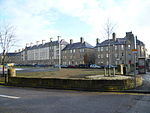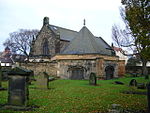Jock's Lodge railway station
1847 establishments in Scotland1848 disestablishments in ScotlandDisused railway stations in EdinburghEdinburgh stubsFormer North British Railway stations ... and 5 more
Pages with no open date in Infobox stationRailway stations in Great Britain closed in 1848Railway stations in Great Britain opened in 1847Scotland railway station stubsUse British English from April 2020
Jock's Lodge railway station served the area of Jock's Lodge, Edinburgh, Scotland from 1847 to 1848 on the Waverley Route and the East Coast Main Line.
Excerpt from the Wikipedia article Jock's Lodge railway station (License: CC BY-SA 3.0, Authors).Jock's Lodge railway station
Piershill Square East, City of Edinburgh Piershill
Geographical coordinates (GPS) Address Nearby Places Show on map
Geographical coordinates (GPS)
| Latitude | Longitude |
|---|---|
| N 55.9566 ° | E -3.1467 ° |
Address
Piershill Square East 5
EH8 7BE City of Edinburgh, Piershill
Scotland, United Kingdom
Open on Google Maps






